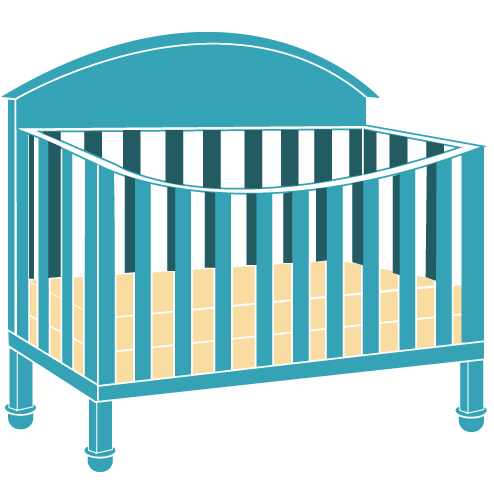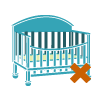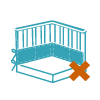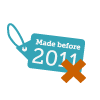Babies probably spend more time in their crib than anywhere else, so while comfort is important, safety is essential. And since most children sleep in a crib until it's time to move into a real bed – typically between the ages of 2 and 3 – you'll also want a sturdy one.
Many moms like to have the crib set up several months before their due date. It's nice to get this task taken care of, but if your baby arrives before your crib does, don't worry. Babies will do fine in a bassinet for the first several weeks or even months.

When it comes time to set up the crib, be sure to choose a spot away from windows, window blinds, and draperies. Babies can strangle on the cords, and older babies could possibly pull themselves up and fall through the window. To keep cords out of your child's reach, use a clamp or clothespin, tie the cord to itself, or cut the loop in half to make two separate cords.
The cord on a baby monitor can also pose a danger. Between 2004 and 2010, the U.S. Consumer Product Safety Commission (CPSC) received seven reports of babies strangled by monitor cords near their crib. Use wireless monitors or keep the cord well away from the crib.
Find out more about crib safety in "what to look for when buying" and "important safety notes," below.
Get safe sleeping tips about crib bedding and sleep position to reduce your baby's risk of SIDS.
What to look for when buying
Safety standards: When you buy a crib, look for the Juvenile Products Manufacturing Association certification. This ensures that the product was tested for quality and safety. Also check BabyCenter's Product Recall Finder to see whether your crib – or the one you're planning to buy – has been recalled.
Slats no more than 2 3/8 inches apart: Your crib should have slats that are close enough together to prevent your baby's head from slipping through or getting stuck. The distance between the crib slats must be no more than 2 3/8 inches (about the size of a soda can)
Safe corner posts: If the crib has corner posts, they should be no higher than 1/16 of an inch (unless they're over 16 inches high to support a canopy). If corner posts are higher than 1/16 of an inch, clothing can catch on them and injure or choke an infant.
Adjustable mattress height: Most cribs let you change the height of the crib mattress by simply raising or lowering the mattress support. The time to lower the mattress is when your child begins sitting up. As kids get more active and move to pulling up and standing, you don't want them to climb or fall out of the crib.
Stability: Give the crib a good shake in the store or after you put it together at home. If it wobbles or rattles, it may have been put together improperly. But wobbling or rattling could also be a sign that you should look for a sturdier crib.
Frame size: The crib interior should snugly accommodate a standard crib mattress – at least 51 3/4 inches long by 27 3/4 inches wide. If you can fit more than two fingers between the side of the mattress and the crib, the mattress is too small. This poses a significant danger, as babies can get trapped in that space. Make sure that with a mattress in place, the crib sides are tall enough to keep your baby safely inside.
Versatility: Many cribs are designed to convert to a toddler bed, a children's bench, or even the headboard and footboard for a full-size bed. While this sounds appealing, make sure that the crib makeover is relatively easy to perform and that you like the look of the new furniture.
Important safety notes
Most new cribs on the market today comply with both mandatory and voluntary safety standards. Read crib safety tips from the American Academy of Pediatrics.
Millions of cribs by major brands have been recalled in recent years (see below for more details). So if you're borrowing or buying a used crib, be sure to check BabyCenter's Product Recall Finder first to make sure it hasn't been recalled.
More safety considerations:
Cribs with drop sides: The rule is simple: Don't use them. The movable railings known as drop sides were common on cribs for decades, but can pose a serious hazard to babies. If the drop side detaches or comes loose, a baby can become entrapped and strangle or suffocate in the space between the drop side and the crib mattress.

At least 32 infants died this way between 2000 and 2010, according to the CPSC. In December 2010, the agency announced strict new safety standards that ban the sale of drop-side cribs, starting in mid-2011.
Bumpers: Crib bumpers – padding that attaches to the inside railings of the crib to cushion all four sides – pose a hazard and are no longer recommended. Bumpers are still a standard feature of crib bedding sets, but a number of organizations, including the American Academy of Pediatrics, now discourage them as a SIDS risk.

Old cribs: Cribs made before 1973, when federal guidelines went into effect, are more likely than newer models to have safety problems. Secondhand cribs may also have splinters, lead paint, discontinued (and potentially dangerous) features, or slats that are too far apart. But even models manufactured as recently as 1991 can be unsafe, so be sure to check slat space size and stability, and look out for any sharp edges, protruding metal, peeling paint, and other dangers. In fact, in 1995, after issuing a warning about the dangers of used cribs – which are responsible for about 50 infant deaths a year – the CPSC announced a roundup to crush and destroy used cribs.

Decorative touches: Avoid fancy decorations that can break off and pose a choking hazard. Cribs with cutout designs along the rail may look pretty, but they could inadvertently trap your baby's arm or neck.

Any crib that appears structurally unsound: The CPSC has received reports of many cases in which cribs have come apart. When this happens, your baby's head can get trapped in the open spaces between the mattress and side rail.
What it's going to cost you
Most models range in price from $100 to $500. Fancier cribs can run $800 to $1,000 or more.





